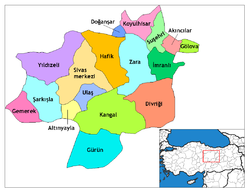Divrigi
| Divriği | |
|---|---|
| Town | |

Divriği, portal of the Darüşşifa hospital adjoining the Great Mosque
|
|
 Location of Divriği within Turkey. |
|
| Location of Divriği within Turkey. | |
| Coordinates: 39°22′N 38°07′E / 39.367°N 38.117°ECoordinates: 39°22′N 38°07′E / 39.367°N 38.117°E | |
| Country |
|
| Region | Central Anatolia |
| Province | Sivas |
| Government | |
| • Mayor | Hakan Gök (CHP) |
| Area | |
| • District | 2,723.77 km2 (1,051.65 sq mi) |
| Population (2012) | |
| • Urban | 10,824 |
| • District | 16,272 |
| • District density | 6.0/km2 (15/sq mi) |
| Time zone | EET (UTC+2) |
| • Summer (DST) | EEST (UTC+3) |
| Website | www.divrigi.bel.tr |
Divriği, historically known as Tephrike (Greek: Τεφρική Tephrike, Armenian: Տեւրիկ Tewrik) and formerly sometimes called Divrik, is a small town and a district of Sivas Province of Turkey. The town lies on gentle slope on the south bank of the Çaltısuyu river, a tributary of the Karasu river.
During the Byzantine period Tephrike was an important stronghold for the dualist heretic Armenian Paulicians. Their leader, Karbeas, founded it ca. 850, and the Paulicians fortified it and used it as refuge and the capital of their state during the ninth century. It was captured by the Byzantine Empire during the reign of Emperor Basil I and was temporarily named Leontokome (after Emperor Leo VI) and made into a thema. In the early eleventh century, the town was part of the territory given to the Armenian king Seneqerim-Hovhannes of Vaspurakan in exchange for his lands in Vaspurakan. Around 1071, after the battle of Manzikert, the area was conquered by a Turkmen warrior named Mengujek Ghazi. A medieval castle, with remains mostly from the thirteenth century, is situated on top of a steep hill overlooking the town.
In 1228-29, while Divriği was under the rule of the Mengujekids, the local ruler Ahmedshah commissioned a mosque (Divriği Great Mosque - Divriği Ulu Camii in Turkish) which stands mostly intact. The mosque, along with the adjoining hospital (Darüşşifa), built at the same time as the mosque by Turan Malik, daughter of the Mengujekid ruler of Erzincan, Fakhreddin Bahramshah, are on UNESCO's World Heritage List by virtue of the exquisite carvings and architecture of both buildings. The complex is considered to be one of the most important works of architecture in Anatolia. The geometrical and floral patterned reliefs found on the main door in particular attract great interest.
...
Wikipedia

